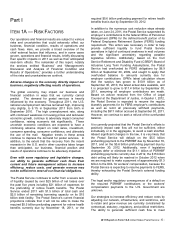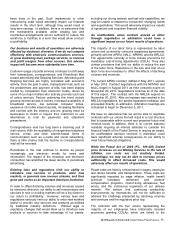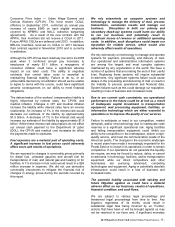US Postal Service 2011 Annual Report Download - page 18
Download and view the complete annual report
Please find page 18 of the 2011 US Postal Service annual report below. You can navigate through the pages in the report by either clicking on the pages listed below, or by using the keyword search tool below to find specific information within the annual report.
2011 Report on Form 10-K United States Postal Service - 16 -
The table below illustrates the loss from ongoing business
activities when these charges are not considered, and
reconciles this amount to our GAAP net loss.
(Dollars in Millions)
2011
2010
2009
Net Loss $ (5,067)
$
(8,505)
$
(3,794)
Impact of:
2,242 2,500 1,343
and PSRHBF expense - 5,500 1,400
$ (2,825)
$
(505)
$
(1,051)
Loss before impact of discount rate changes, actuarial revaluations,
and PSRHBF expense
Discount rate changes and
actuarial revaluation of Workers'
Loss before impact of discount
rate changes, actuarial
revaluations, and PSRHBF
expense
Without the impact of these charges, the net loss would
have been $2,825 million in 2011, $505 million in 2010
and $1,051 million in 2009.
Due to the combined effects of decreasing revenue and
legislatively mandated costs, we have suffered losses in
every quarter since Quarter I, 2008, except Quarter IV,
2011 and Quarter IV, 2009. These two quarters would
have also shown losses if P.L. 112-33 and P.L. 111-68
had not reduced those year’s retiree health benefits
prefunding contributions from $5.5 billion to zero in 2011
and from $5.4 billion to $1.4 billion in 2009. No similar
legislation was enacted in 2010 and we therefore made
the full $5.5 billion scheduled payment for that year.
Despite these financial challenges, in 2011 we were able
to increase operating efficiency. Operating efficiency, as
measured by Total Factor Productivity (TFP), increased
1.3% in 2011 and 2.2% in 2010 as compared to the
previous year. This marked the tenth year of positive TFP
growth since 2000 and cumulative growth of 21.6% since
1972.
Productivity gains are a result of effective workforce
management, efficient use of material (supplies and
services including transportation), and maximizing the
return-on-capital investments (mainly automation). Work
hours in 2011 were reduced by 34 million, or 2.9% despite
an increase of approximately 636,500 delivery points,
while mail volume declined 1.7%.
For the year ended September 30, 2011, operating
revenue was $65,711 million, compared to $67,052 million
in 2010, a decrease of $1,341 million, or 2.0%, despite an
average Mailing Services price increase of 1.7% in April
2011 and Shipping Services price increases of 3.6% and
3.3% in January 2011 and 2010, respectively. There were
no price increases for Mailing Services products during
2010.
In 2011, Shipping Services revenue increased by $530
million or 6.3% on a volume increase of 6.0%. However,
these increases were not enough to offset a decrease in
Mailing Services of $1,871 million or 3.2% driven by
decreases in First-Class Mail revenue and volume. The
decline in First-Class Mail revenue and volume, our most
profitable product, reflects the impact resulting from
continuing migration away from First-Class Mail toward
electronic alternatives.
Operating expenses in 2011 were $70,634 million,
compared to $75,426 million in 2010, a decrease of
$4,792 million, or 6.4%. Compensation and benefit
expense in 2011 decreased by $599 million, or 1.2%, due
primarily to the reduction of 34 million workhours. Due to
the passage of P.L. 112-33 and the resulting shift of the
scheduled 2011 $5.5 billion annual prefunding of the
PSRHBF from 2011 to 2012, total retiree health benefits
expenses decreased by $5,306 million, or 68.5% in 2011
from 2010.
Total workers’ compensation expenses rose by $106
million, or 3.0%. Included in the total $3,672 million
workers’ compensation expense is $2,242 million related
to changes in the discount rate and the actuarial
revaluation of future estimated payments. The discount
rate change is further discussed in the “Workers’
Compensation” section below and in Note 9, Workers’
Compensation, in the Notes to the Financial Statements.
Transportation expenses increased $511 million, or 8.7%,
driven by sharply higher fuel prices which more than offset
decreases in mail volume and higher utilization rates.
Other expenses increased $496 million or 5.3%.
As shown in the chart below, total operating expenses
would have been $68,392 million in 2011, an increase of
$966 million, or 1.4% from 2010 if the impact of the
discount rate and actuarial revaluation changes and
required PSRHBF prefunding payments are excluded.
(Dollars in Millions) 2011 2010 2009
Operating Expenses $ 70,634 $ 75,426
$
71,830
Impact of:
2,242 2,500 1,343
PSRHBF Expense - 5,500 1,400
$ 68,392 $ 67,426
$
69,087
Operating Expense before impact
of discount rate changes, actuarial
revaluations, and PSRHBF
expense
Discount changes and actuarial
revaluation of Workers'
Compensation
Operating Expense before impact of discount rate changes,
actuarial revaluations, and PSRHBF expense
For 2010, the net loss was $8,505 million, compared to a
$3,794 million net loss in 2009. Operating revenue of
$67,052 million in 2010 was 1.5%, or $1,038 million, less
than operating revenue of $68,090 million in 2009. The
volume of First-Class Mail declined in 2010 compared to
2009 while Standard Mail and Shipping Services volume
remained relatively flat.
























